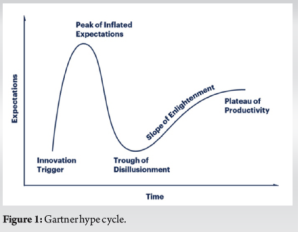Dr. Mantu Jain, Department of Orthopaedics, AIIMS Bhubaneswar, Bhubaneswar, Odisha, India. E-mail: montu_jn@yahoo.com
Surgical innovations have driven advancements in patient care, leading to improved surgical results and decreased patient morbidity. The integration of new technical advancements in orthopedic surgery is linked to the clinical advantages, ethical challenges, financial factors, and its broader influence on the global health-care sector [1]. 3D printing in orthopedic surgery is a developing technique that is rapidly gaining recognition and positively impacting patient results. The widespread influence and usefulness of 3D printing in orthopedics have been confirmed through reports detailing its application in complex trauma, complex hip revision surgeries, and various other areas such as complex spine deformity for pedicle screw trajectory guides, 3D printed implants, and bio-scaffolds [2-5]. The amount of scientific literature on the use of 3D printing in orthopedics has significantly increased in the past decade, both internationally and in India [6]. However, it has this quickly rising trend in the field of orthopedic surgery “really arrived in India.”
Emerging technologies in various fields, such as industrial or medical advancements like surgical advances, are said to progress through specific stages, as outlined in the Gartner hype cycle [7]. An investigation of the scientific research and applications of 3D printing technology in the field of orthopedics in India is warranted to determine if it is experiencing a comparable cycle. The authors conducted a comprehensive literature search on the research conducted by Indian Orthopaedic surgeons in 3D printing, focusing on PubMed, Scopus, and Cochrane database. The search revealed a clear pattern in the publication trends. The initial report by Bagaria et al. on complex trauma and revision hip arthroplasty in 2011 was followed by a period of limited published literature until 2016 [8]. This period marked a significant increase in scientific publications from the Indian dataset in the following years. The primary focus of research in the Indian Orthopaedic community has been on patient-specific instrumentation, complex trauma, revision arthroplasty, spine surgery, and bio-printable implants [4, 9-13]. Surgical teams in the country have been supported by professionals with engineering backgrounds [14, 15], who have published significant work on the application of additive manufacturing to advance emerging surgical technologies.
The global evolution of 3D printing industry since 1983, when Chuck Hull devised additive manufacturing in a non-medical scenario [16] has progressed to the stage of rapid prototyping machines to “precision manufacturing units”. The global 3D printing market size was valued at USD 20.37 billion in 2023 and is expected to register a compounded annual growth rate (CAGR) of 23.5% from 2024 to 2030 and the 3D printing medical devices market was USD 2.4 billion in 2021 [17]. In a report, published in 2023, the market for 3D printing in healthcare is growing. Indian 3D printing market Size is estimated to grow at a CAGR of 20.3% during the forecast period [18]. In context to the Indian scenario, we are ahead in the curve, due to the revival and persistent thrust on indigenous start-ups of software engineers, designers, and manufacturers. The essence of the revived enthusiasm in 3D printing is due to the drastic reduction in turnover time, a much closer coordination with the designers, an overall reduction in the designing and innovation cost, adding value to the concept. This in turn is facilitating bespoke solutions for a wide spectrum of orthopedic solutions in a much faster and cheaper way. However, a definitive cost analysis for 3D printing applications in orthopedics in the Indian scenario is still not available, to gauge the true evolution of the technology in this context.
Shah et al. [19] and Kabra et al. [4] and various other research groups in the field have emphasized the cost implications linked to 3D printing. Tetsworth et al. concluded that while the initial cost of 3D printing may be too high for surgeons in developing countries, as 3D printer prices decrease, the ability to create prototypes and patient-specific models will become more affordable [1]. Yet, in the varied clinical environment of our nation, the expenses related to 3D printing, software, materials, and individuals trained in design remain high for surgical teams in smaller facilities compared to larger tertiary care centers. Despite the increasing number of 3D printing production units in the country, there is a good and hopeful trend regarding the cost-effectiveness of this technology. The competent authorities must handle regulatory concerns, especially about approval from the US FDA or the Indian regulatory agency. At present, 3D-printed implants and gadgets are not included in the list of approved medical implants by the regulatory authorities in our nation. Adding this subset to the list could be a vital step in reducing the cost of 3D-printed implants and the overall process, perhaps revolutionizing the field.
Has 3D Printing in Orthopedics Really Arrived in India 3D printing, as an emerging technology made its presence felt almost 15 years ago, and as in case of any surgical advance, went through the stages of Gartner hype cycle (Fig. 1) [6]. The Indian orthopedic surgeons have shown a noticeable influence of 3D printing in their clinical practice through a wide range of clinical applications and scholarly publications released in the past decade. It would be quite logical to interpret the evolution of 3D printing applications in orthopedics, similar to the “innovation trigger,” paving way for the “slope of enlightenment” by the dawn of last decade. The quantum of scientific work underway and published from the Indian Centres, highlights the steady growth of this emerging technology, prudent to be labeled in the stage of “plateau of productivity.” However, it may be premature to categorize the entire and comprehensive impact of 3D printing in the healthcare industry, specifically in the context of orthopedic surgery in our country, as “major.” The main obstacles preventing wider use of this technology include lack of regulation in the 3D printing sector of the medical industry, need for further cost regulation in the national context, shortage of skilled designers in lesser developed areas of the country, and a need for increased awareness among orthopedic professionals about the benefits of this new technology.
References
- 1.Wyatt RW, Jayakumar P, Barber TC, Fleeter TB, Graves SE, Bozic KJ. A strategic approach to introducing new technology into orthopaedic practices. Instr Course Lect 2020;69:393-404. [Google Scholar]
- 2.Kumar L, Haleem A, Javaid M. Impact of three dimensional printing in orthopedics. Glob Health J 2021;5:178-82. [Google Scholar]
- 3.Bagaria V, Chaudhary K. A paradigm shift in surgical planning and simulation using 3Dgraphy: Experience of first 50 surgeries done using 3D-printed biomodels. Injury 2017;48:2501-8. [Google Scholar]
- 4.Kabra A, Mehta N, Garg B. 3D printing in spine care: A review of current applications. J Clin Orthop Trauma 2022;35:102044. [Google Scholar]
- 5.Vaishya R, Haleem A. Technology and orthopaedic surgeons. J Orthop 2022;34:414-5. [Google Scholar]
- 6.Vaishya R, Patralekh MK, Vaish A, Agarwal AK, Vijay V. Publication trends and knowledge mapping in 3D printing in orthopaedics. J Clin Orthop Trauma 2018;9:194-201. [Google Scholar]
- 7.Gartner hype cycle.Available from: https://www.gartner.com/en/research/methodologies/gartner-hype-cycle. Accessed May21, 2024 [Google Scholar]
- 8.Bagaria V, Deshpande S, Rasalkar DD, Kuthe A, Paunipagar BK. Use of rapid prototyping and three-dimensional reconstruction modeling in the management of complex fractures. Eur J Radiol 2011;80:814-20. [Google Scholar]
- 9.Lal H, Patralekh MK. 3D printing and its applications in orthopaedic trauma: A technological marvel. J Clin Orthop Trauma 2018;9:260-8. [Google Scholar]
- 10.Kumar P, Vatsya P, Rajnish RK, Hooda A, Dhillon MS. Application of 3D printing in hip and knee arthroplasty: A narrative review. Indian J Orthop 2021;55:14-26. [Google Scholar]
- 11.Vaishya R, Vijay V, Vaish A, Agarwal AK. Three‐dimensional printing for complex orthopedic cases and trauma: A blessing. Apollo Med 2018;15:51-4. [Google Scholar]
- 12.Gadia A, Shah K, Nene A. Emergence of three-dimensional printing technology and its utility in spine surgery. Asian Spine J 2018;12:365-71. [Google Scholar]
- 13.Garg B, Gupta M, Singh M, Kalyanasundaram D. Outcome and safety analysis of 3D-printed patient-specific pedicle screw jigs for complex spinal deformities: A comparative study. Spine J 2019;19:56-64. [Google Scholar]
- 14.Rouf S, Malik A, Raina A, Irfan Ul Haq M, Naveed N, Zolfagharian A, et al. Functionally graded additive manufacturing for orthopedic applications. J Orthop 2022;33:70-80. [Google Scholar]
- 15.Malik A, Rouf S, Ul Haq MI, Raina A, Valerga Puerta AP, Sagbas B, et al. Tribo-corrosive behaviour of additive manufactured parts for orthopaedic applications. J Orthop 2022;34:49-60. [Google Scholar]
- 16.Whitaker M. The history of 3D printing in healthcare. Bulletin 2014;96:228-9. [Google Scholar]
- 17.3D printing market size and trends. Available from: https://www.grandviewresearch.com/industry-analysis/3d-printing-industry-analysis. Accessed May21, 2024 [Google Scholar]
- 18.India 3D Printing Market 2023 – Market Size & Segments Analysis, Industry Trends, Manufacturers Analysis, Opportunities and Forecast 2032 Available from: https://www.xresearch.biz/shop/india-3d-printing-market?trk=article-ssr-frontend-pulse_little-text-block. Accessed May21, 2024 [Google Scholar]
- 19.Shah D, Naik L, Paunipagar B, Rasalkar D, Chaudhary K, Bagaria V. Setting up 3D printing services for orthopaedic applications: A step‐by‐step guide and an overview of 3DBioSphere. Indian J Orthop 2020;54:217-27. [Google Scholar]









